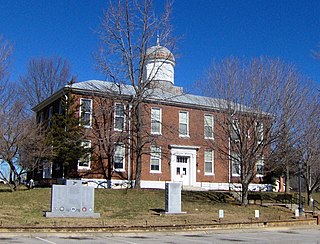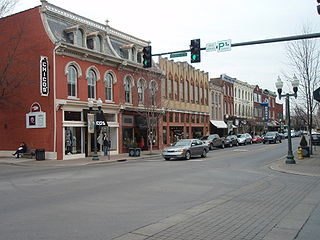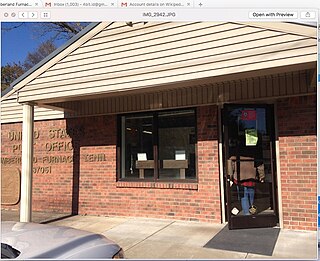
Humphreys County is a county located in the western part of Middle Tennessee, in the U.S. state of Tennessee. As of the 2020 census, the population was 18,990. Its county seat is Waverly.

Dickson County is a county located in the U.S. state of Tennessee. As of the 2020 census, the population was 54,315. Its county seat is Charlotte. Dickson County is part of the Nashville-Davidson–Murfreesboro–Franklin, TN Metropolitan Statistical Area. Dickson County is home to Tennessee's oldest courthouse in continuous use, built in 1835. This is the second courthouse in Charlotte as the first one, a log building, was destroyed in the Tornado of 1833, which destroyed all but one building on the courthouse square.

Sevierville is a city in and the county seat of Sevier County, Tennessee, United States, located in eastern Tennessee. The population was 17,889 at the 2020 United States Census.

Franklin is a city in and county seat of Williamson County, Tennessee, United States. About 21 miles (34 km) south of Nashville, it is one of the principal cities of the Nashville metropolitan area and Middle Tennessee. As of 2020, its population was 83,454. It is the seventh-largest city in Tennessee. Franklin is known to be the home of many celebrities, mostly country music stars.

The Athenaeum Rectory is a historic building in Columbia, Tennessee that features both Gothic and Moorish architectural elements. Completed in 1837, the building originally served as the rectory for the Columbia Female Institute and as the residence of the school's first president, the Reverend Franklin Gillette Smith. The structure was added to the National Register of Historic Places in 1973.

Cumberland Furnace is an unincorporated community in Dickson County, Tennessee, United States. Cumberland Furnace is served by a U.S. Post Office, ZIP Code 37051.
This is a list of the National Register of Historic Places listings in Knox County, Tennessee.

Rattle and Snap is a plantation estate at 1522 North Main Street in Mount Pleasant, Tennessee. The centerpiece of the estate is a mid-1840s mansion that is one of grandest expressions of the Greek Revival in Tennessee. It was designated a National Historic Landmark in 1971 for its architecture, and for its association with the Polk family, once one of eastern Tennessee's largest landowners. The house is privately owned, but may be viewed by appointment.

The Clement Railroad Hotel Museum, housed in the Tennessee Historical Commission’s Hotel Halbrook State Historic Site and operated by the Governor Frank G. Clement Railroad Hotel and Historical Museum Corporation, Inc. The building is one of the few remaining examples of a railroad hotel in the State of Tennessee. It is located in historic downtown Dickson, Tennessee and since opening on June 2, 2009, the museum has hosted thousands of visitors.
This is a list of the National Register of Historic Places listings in Dickson County, Tennessee.
The Tennessee Historical Commission (THC) is the State Historic Preservation Office for the U.S. state of Tennessee. Headquartered in Nashville, it is an independent state agency, administratively attached to the Department of Environment and Conservation. Its mission is to protect, preserve, interpret, maintain, and administer historic places; to encourage the inclusive diverse study of Tennessee's history for the benefit of future generations; to mark important locations, persons, and events in Tennessee history; to assist in worthy publication projects; to review, comment on and identify projects that will potentially impact historic properties; to locate, identify, record, and nominate to the National Register of Historic Places all properties which meet National Register criteria, and to implement other programs of the National Historic Preservation Act of 1966 as amended. The Tennessee Historical Commission also refers to the entity consisting of 24 Governor-appointed members and five ex officio members.

The Calvary Episcopal Church is a historic Episcopal church located off Tennessee State Route 48 in Cumberland Furnace, Tennessee.

The Brainerd Mission was a Christian mission to the Cherokee in present-day Chattanooga, Tennessee. The associated Brainerd Mission Cemetery is the only part that remains, and is listed on the National Register of Historic Places.
The William Allison House near College Grove, Tennessee is an antebellum, brick central passage plan house with Federal style detailing built during 1827–1832. It is a two-story house with a two-story rear ell and exterior brick chimneys. It has a one-story shed-roof addition from c. 1860 and a c. 1940 porch.
Smithson–McCall Farm is a 256.3-acre (103.7 ha) historic district in Bethesda, Tennessee. The farm was listed under the National Register of Historic Places in 2007. The listing claims that the property "documents the impact of the progressive agricultural movement of the early twentieth century on the operations and landscape of a middle-class family farm," and includes an "architecturally significant group of buildings and structures, placed within an agricultural landscape of high integrity...that represents a good example of farmstead architecture in Middle Tennessee and that reflects the impact of the Progressive Farm movement of the early twentieth century".

The Boyd–Wilson Farm is a 157-acre (64 ha) historic district in Franklin, Tennessee, United States. The circa 1840 farm includes an I-house.

The Apheus Truett House is a frame house located at 228 Franklin Road in Franklin, Tennessee, that was listed on the National Register of Historic Places (NRHP) in 1988. Built in 1846, it is a notable example of a two-story vernacular I-house structure in Williamson County. It includes Central passage plan architecture. The NRHP listing is for an area of 5.2 acres (2.1 ha), with one contributing building and two non-contributing structures.

The James Scales House, built c. 1885 in Kirkland, Tennessee, United States, along with the William W. Johnson House, another Williamson County house, are notable as late 19th century central passage plan residences that "display period decoration at eaves and porch." It includes Stick/Eastlake, I-house, and central passage plan architecture.
The Samuel F. Glass House is a property in Franklin, Tennessee that dates from 1859. It was listed on the National Register of Historic Places in 1988. It has also been known as Pleasant View.

The Dickson County War Memorial Building is a historic building in Dickson, Tennessee, U.S.. It was built in 1932–1933. It was designed in the Colonial Revival architectural style by Emmons H. Woolwine. It was home to the Dickson County Library from 1933 to 1939, when it was used for the Draft board. It has been listed on the National Register of Historic Places since March 18, 1999.















